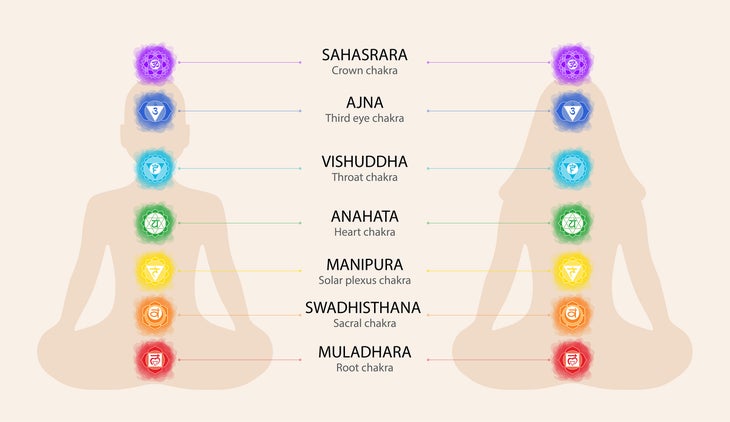Heading out the door? Read this article on the new Outside+ app available now on iOS devices for members! Download the app.
Wouldn’t it be nice if our problems were left behind with our shoes when we step into the yoga studio? Too often, we get on the mat feeling overwhelmed with worry or stymied by a relationship conflict. The good news: The right class can leave us feeling clearer, lighter, and refreshed. Credit the stress-busting powers of a good workout? Sure. But the ancient yogis—and many teachers today—would also chalk this up to the unique way that yoga poses and breathwork move blocked prana (life force) through the subtle body via seven vortexes of energy known as chakras.
According to yoga tradition, the chakras are part of the subtle body, a part of you that you can’t see or touch. It’s where your energy flows, which is why it’s also referred to as the energy body.
Chakra literally means “spinning wheel.” The chakras are thought to be spinning disks of energy that should stay “open” and aligned for optimal emotional and physical well-being. If energy becomes blocked in one of the chakras, it triggers physical, mental, or emotional imbalance. For example, you may feel symptoms such as anxiety, lethargy, or poor digestion. A well-tuned asana practice can free up energy and stimulate an imbalanced chakra, paving the way for that wonderful internal shift for which yoga is known. With just a little bit of coaching, you can tap into the chakras as a potent way of harnessing and shifting your energy in the direction you want it to go.
Listen to Wheels of Life: A User’s Guide to the Chakra System
Understanding the chakras
Think of chakras as a blueprint for your own self-care, and your yoga practice as the architect that makes that blueprint a reality. The most direct way to use the chakras is to learn how each one is associated with an element in nature. As Alan Finger, founder of ISHTA Yoga, explains, the first five chakras are associated with the physical elements earth, water, fire, air, and ether (or space). The last two chakras are thought to connect us beyond the earthly realm, so they are associated with the elements of light and cosmic energy.
Once you learn the element that each chakra is associated with, you can start to suss out how that element feels in your body. Thinking about your body in these symbolic terms can help you access new stores of energy. For example, the root chakra is associated with earth. When it’s in balance, we feel strong and grounded; when it’s out of balance, we may feel unrooted and insecure. Or take the pelvic chakra, which is associated with water. When it’s in balance, we feel fluid and like our creative juices are flowing. When it’s not, we might feel rigid, dry, or emotionally brittle, like a plant that hasn’t been watered enough.
See also: I Was a Skeptic of Chakra Balancing…And Then I Tried It
What are the chakras?
There are seven chakras that run from the base of your spine to just above the top of your head.
- Muladhara (Root Chakra)
- Svadhisthana (Sacral or Pelvic Chakra)
- Manipura (Navel Chakra)
- Anahata (Heart Chakra)
- Vishuddha (Throat Chakra)
- Ajna (Third-Eye Chakra)
- Sahasrara (Crown Chakra)

There are 7 chakras or energy centers in the body
Try 16 x 20 Chakra Chart Poster
Balancing the chakras with yoga
To restore balance in your chakras, first tune in to how you’re feeling. Then, figure out which chakra to stimulate to counteract the imbalance. For example, if you’re feeling low in energy, you can do poses that target the navel chakra to rekindle your inner fire. If you’re feeling anxious and long to feel more grounded, choose poses for the earthy root chakra. Or if you seek more courage to speak your truth, the right poses can open and stimulate the throat chakra.
The effects of a chakra-based practice can have a tangible, empowering ripple effect on your life. Jasmine Tarkeshi, vinyasa teacher and cofounder of Laughing Lotus Yoga Center, in San Fransisco, says she’s been doing more root-chakra practices since becoming a mom, and the effect is palpable. “If I’m feeling frenzied, I hold the poses longer to feel more grounded and present,” she says. “It informs the rest of my day to the point where maybe I’m not losing my keys so much or I’m not so busy or forgetful that I skip lunch. If I specifically use the poses medicinally rather than just haphazardly, I can really change my day.”
Watch the 5-Minute Chakra Balancing Flow Video >
Each of the poses Tarkeshi recommends below is designed to address a corresponding chakra and its associated life issues. You can do the entire sequence, or focus on the pose or poses that speak to areas in your life that need attention. For a more restorative, meditative approach, first close your eyes while seated and envision the color associated with the chakra radiating from the chakra’s location, as you repeat the sound associated with it. And to help you focus and go deeper into each asana, try repeating the associated chakra sound while practicing.
Remember, the changes to the subtle body can’t be touched or measured as you would your heart rate or height. You have to trust your inner experience to feel them and to recognize their benefits. Claire Missingham, a London-based vinyasa flow yoga teacher, advises trying chakra-based poses for four weeks and keeping a journal of how you feel after each practice. Keep your notes simple, and write down any changes you feel in your energy, such as, “calmed me down” or “helped me communicate more clearly.” Keeping track this way just might help you see how tuning in to the chakras can help you shift more than just your physical state.
Try Elixir By Bita 7 Chakras Set
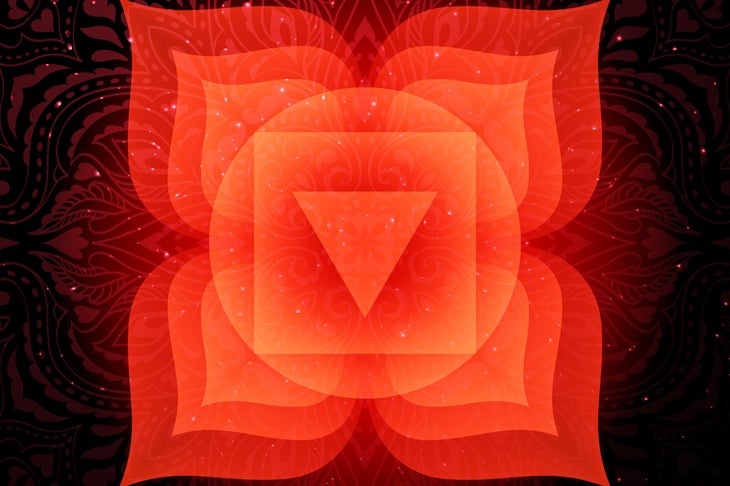
Muladhara (Root Chakra)
Element: Earth
Color: Red
Sound: Lam
What it is: The Muladhara chakra is found at the pelvic floor. It is our tap root and keeps us grounded into embodied reality, physically strong and secure. This chakra governs your family ties and feelings of survival, belonging, and guardedness. Your earliest memories are stored in the muladhara chakra, including whether or not your basic needs were met.
The root chakra holds our instinctual urges around food, sleep, sex, and survival. It is also the realm of our avoidances and fears.
When it’s blocked: When this chakra is blocked or out of balance, you can become needy, have low self-esteem, or have self-destructive behaviors. When Muladhara is in balance, you feel strong and confident; you can stand up on your own two feet and take care of yourself.
Pose: Vrksasana (Tree Pose)

Stand with your feet hip-width apart, creating a stable base. On an exhale, soften your knees, and release your tailbone as you engage your thighs. Draw the sole of your right foot to the inside of your left inner thigh or calf; continue dropping your tailbone and engaging the standing leg’s thigh to keep the stable alignment you had standing on both feet. Press through your left foot as you lift through the crown of your head. Hold for 5 breaths, and switch sides. Allow gravity to root you down, while noticing how prana moves up your spine.
See also Root Chakra Tune-Up Practice
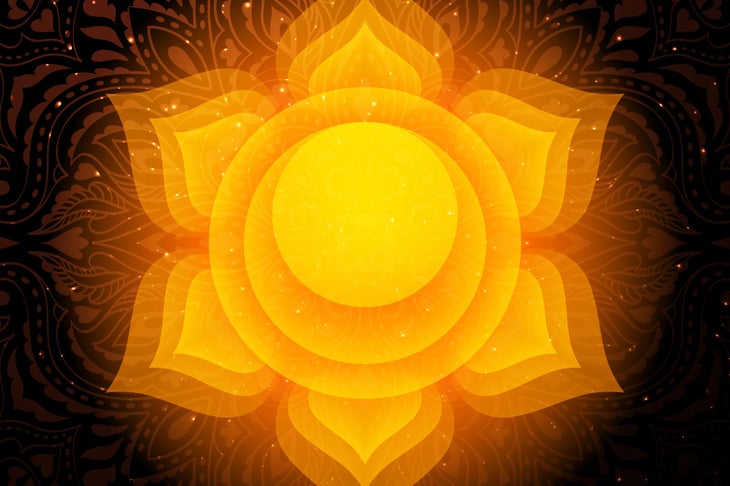
Svadhisthana (Sacral or Pelvic Chakra)
Element: Water
Color: Orange
Sound: Yam
What it is: This chakra is held in our sacrum. It corresponds with your reproductive and sexual organs, and represents fluidity, creativity, and fertility. You can take a literal interpretation of this, or associate this chakra with whether or not you feel deserving of a pleasurable, abundant, creative life.
When it’s blocked: When this chakra is out of balance, you can feel emotionally unstable, guilty, or hard on yourself. When Svadhisthana in balance, you feel creative, positive, and receptive to change—like the ocean and its tides, you’re in the flow.
Pose: Deviasana (Goddess Pose)
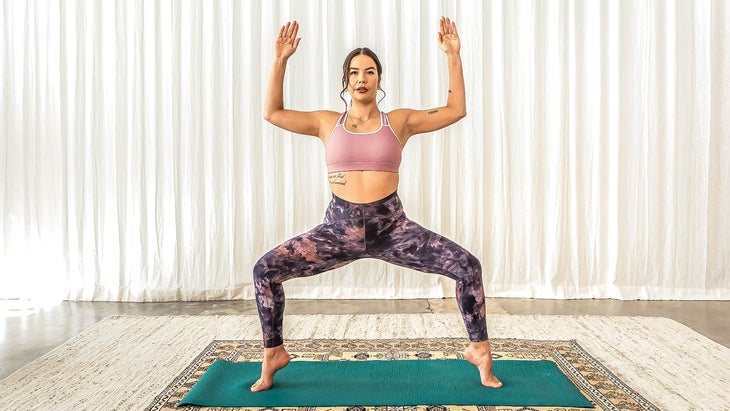
Step your feet wide, turn your toes out, and sink your hips far enough to bring each knee over its corresponding ankle. Place your hands on your thighs and draw your tailbone down as the pubis lifts. Breathe deeply and move side to side, rocking your pelvis back and forth. You can fold down and move your arms side to side between your feet. The point is to enjoy the movement. Feel free to sigh or make sounds. Hold for 8-10 breaths. By opening the hips, you draw focus to the reproductive organs; in swaying, you recognize life’s ebb and flow.
See also Sacral Chakra Tune-Up Practice
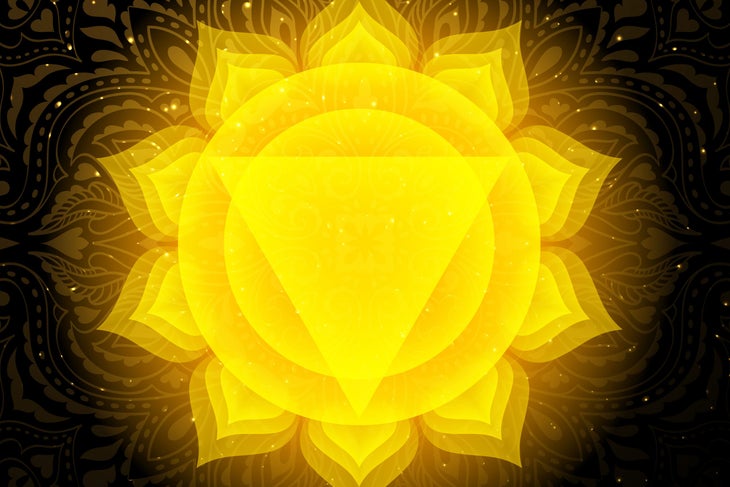
Manipura (Navel Chakra)
Element: Fire
Color: Yellow
Sound: Ram
What is it: Located at the navel, this energy center, one of the chakras, is associated with the digestive system, the element of fire, and individual power and purpose. You’ve heard the expression “firing on all cylinders.” Think of this chakra as your body’s energy power-house.
When it’s blocked: When the Manipura is in balance, you feel alive and have the self-esteem and confidence to take action and be productive. When it’s blocked, you lack courage, have low self-esteem, and feel stagnant and inert. By working on this chakra, you can awaken your true personal inner power and work through your fear of taking risks.
Pose: Navasana (Boat Pose)
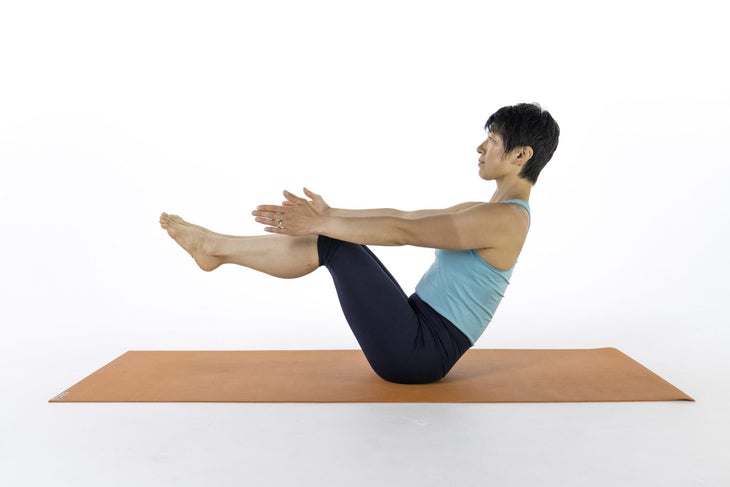
Begin seated with your legs ahead of you. Hug your knees into your chest, and then grab behind your knees to help lift your feet off the floor and balance on your sitting bones. Lift your chest, and draw your shoulders down. Shift your weight forward to the front of your sitting bones as you draw in your navel, engaging your abdominals, and extend your arms forward and your legs up into Navasana. As you exhale, cross your arms at your chest, and lower your legs until they’re a few inches off the ground; inhale to rise back to Navasana. Repeat 5 times, and then lower to your back. Boat is an energizing pose that ignites your core muscles, creating power for transformation.
See also Navel Chakra Tune-Up Practice

Anahata (Heart Chakra)
Element: Air
Color: Green
Sound: Yam
What is it? The heart chakra is in the center of your chest. According to yoga tradition, it is the very “seat of the soul.” Associated with the lungs and the element of air, we can imagine the heart chakra as the meeting ground for the vast spectrum of our human emotional experience. The heart chakra has the capacity to radiate the highest aspects of the human being: compassion, unconditional love and total faith in the Divine. But it also has the capacity to radiate our deepest feelings of insecurity, disappointment, loneliness and despair.
When it’s blocked: As with the other chakras, blocked energy here can manifest in physical and emotional issues. When the heart chakra is blocked, you become possessive and codependent, and may form dysfunctional relationships. You may also stay isolated for fear of rejection. When you stimulate the Anahata chakra, you can heal past wounds by reopening your heart, learn to love unconditionally, and form healthy relationships.
Pose: Ustrasana (Camel Pose)
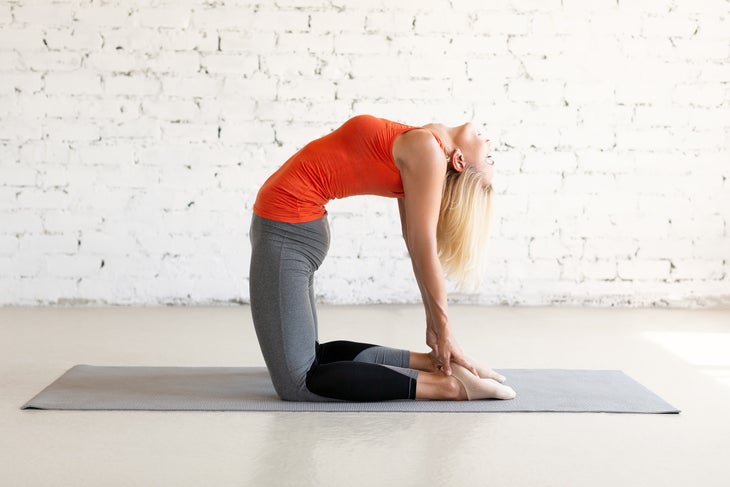
Come to your knees, and sit back on your heels. Join your hands at your heart center. Tuck your toes and rise to bring your hips over your knees, making sure knees and toes are hip-width apart. Place your palms on your lower back with the fingers pointing up and gently draw your sacrum down, as your front hip bones lift. Keep your chin in toward your chest, and lean back. Hug the shoulder blades toward each other. Stay here and breathe, or reach for your heels with your hands. The head is the last thing to release, if it’s comfortable. After a few breaths, bring your hands back to your sacrum and sit on your heels, returning your hands to prayer and bowing your head. Camel opens the heart center. Before you arch back, consider dedicating the posture to someone for whom you feel compassion.
See also Heart Chakra Tune-Up Practice
Try Goddess Garden Chakra Aromatherapy Bracelet
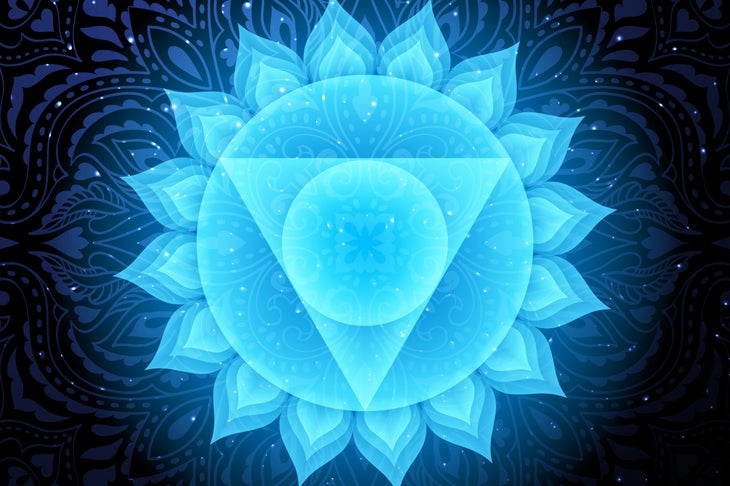
Vishuddha (Throat Chakra)
Element: Ether
Color: Blue
Sound: Ham
What is it? Vishuddha is the energetic home of speech and hearing, and the endocrine glands that control metabolism. On a spiritual level, this chakra is all about expanding our conversation to the Divine.
When it’s blocked: When this chakra is blocked, you may feel like you can’t find your voice or your truth. You may also be overly talkative and not listen to others. When this chakra is open and stimulated, your voice moves through space to help you communicate your emotions in healthy ways. You also become better at listening to others and honoring their personal truths without judgment.
Pose: Salamba Sarvangasana (Supported Shoulderstand)
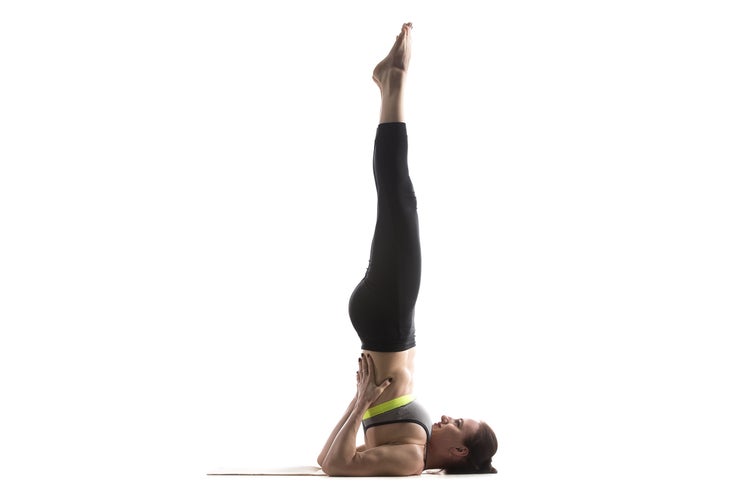
Lie down with your shoulders supported on a folded blanket, head on the floor. Bend your knees, rock your hips up, lift your legs overhead, and then release your toes toward the floor beyond the crown of your head. Place your hands midback, and lift one leg at a time skyward. Allow your gaze to drop toward your heart, and hear the sound of your breath. Feel free to express yourself by joining the soles of the feet, or by lowering one leg at a time toward the floor. Hold for up to 2 minutes. To release, lower both feet to the floor above your head, release your hands to the floor, and lower yourself vertebra by vertebra. Freeing the neck and spine, and then turning the senses in toward your breath, allows you to connect with your own rhythm.
See also Throat Chakra Tune-Up Practice
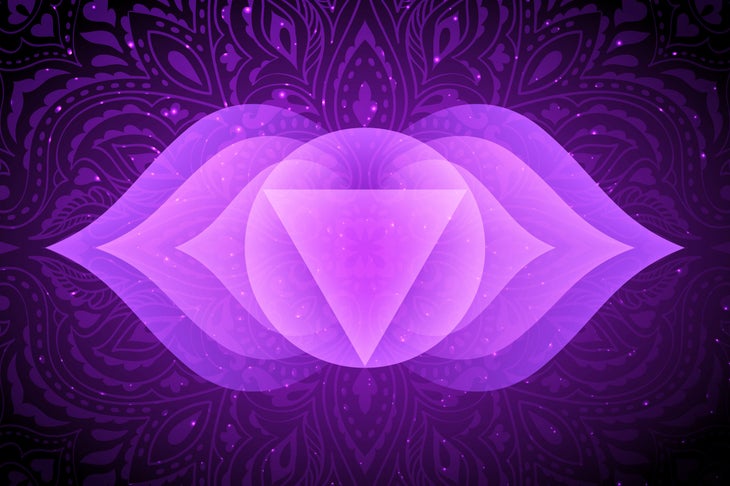
Anja (Third-Eye Chakra)
Element: Light
Color: Indigo
Sound: OM
What is it? This chakra is is located eyebrow level mid-brain and is associated with your intuition, or sixth sense. It governs how the rest of the chakras function. It is the meeting point between two important energetic streams in the body, the ida and pingala nadis, and the place where the mind and the body converge.
When it’s blocked: When Ajna chakra is functioning well, you have insight, and you trust your inner wisdom to face life’s challenges and choices. Physically, it is connected to the pituitary gland, growth, and development. When this chakra blocked, you feel close-minded, too attached to logic, untrusting, and cynical. Working on the sixth chakra opens your mind to the bigger picture and different perspectives, and it helps you receive the wisdom that cannot be seen or heard by ordinary senses.
Pose: Sukhasana (Easy Pose)
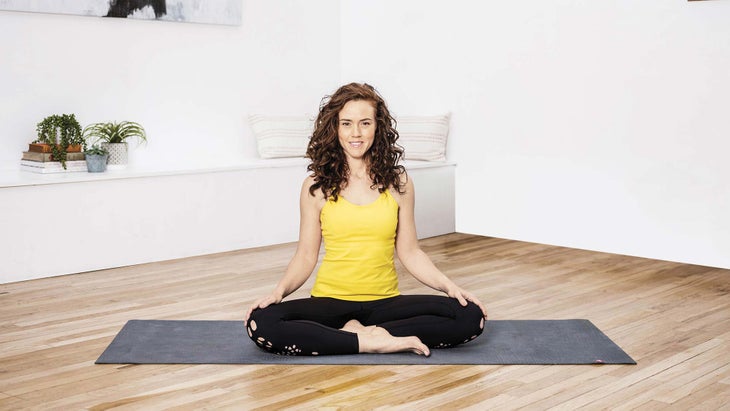
Come to a seat. Fold one heel in toward your groin, and then the other. If your knees aren’t lower than your hips, sit on a folded blanket. Cup your palms toward each other, touching opposite fingertips in Hakini Mudra. For 10 breaths, close your eyes, pose a question to yourself, and focus on the sound of your breath, placing the tip of your tongue to the roof of your mouth as you inhale, and relaxing it as you exhale. Release the backs of your hands to your knees, and see if you sense an answer. Stay here for up to 5 minutes. Hakini Mudra is known to increase the power of concentration, and in this pose you can easily access calm focus.
See also Third-Eye Chakra Tune-Up Practice
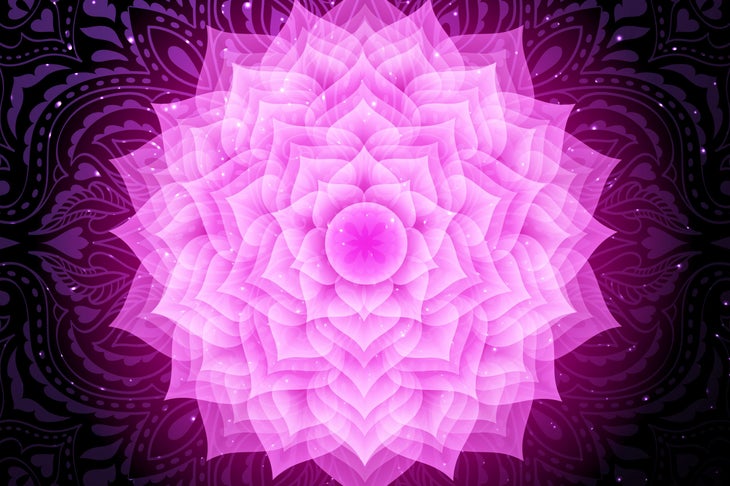
Sahasrara (Crown Chakra)
Element: Cosmic Energy
Color: Violet or White
Sound: OM
What is it? The seventh of the chakras, the crown chakra, connects to beauty itself and the spiritual realm. It helps you to understand who you are beyond your physical self—that you are a spiritual being having a human experience. This chakra links us to everything that is beyond our ego. It is everything that lies beyond our linear intellect and personal needs, preferences and emotional experiences. It is the gateway and source point into enlightenment. The crown chakra is not located in the body but actually hovers above the crown of the head.
When it’s blocked: When the crown chakra is closed, you think happiness can only come from the outside, and you suffer. Working on this chakra helps you to feel free in any situation.
Pose: Savasana (Corpse Pose)

Make sure you’re warm and comfortable, and lie down on your back. You can cover yourself with a blanket, cover your eyes with an eye pillow, or place a rolled-up blanket under your knees or head. Open your legs hip-width apart, and release your arms to your sides with your palms facing up. Take a deep breath and squeeze every part of your body tight, lifting your head, arms, and legs off the floor. Hold for a moment, and let everything go with a big exhale out of the mouth. Do this several times. Imagine a lotus flower at the crown of your head. With every inhale, imagine Divine light pouring in through the flower, and with every exhale, let go of anything that binds you to the past. Stay for 5–20 minutes, then slowly bring your awareness back to your breath, and move your fingers and toes to reconnect to your physical body without losing your connection to your infinite self.
See also Crown Chakra Tune-Up Practice
The takeaway
The chakras are 7 energy centers that extend from the base of your spine to just over the top of your head. When prana (energy) flows through them easily your physical, emotional, and mental health all improve. When the chakras become blocked, you may experience physical or emotional symptoms.
Each of the chakras has its own distinct properties, but they work together as a whole. Meaning: if one of the chakras is out of balance, it can put the entire system out of whack. Yoga poses—along with meditation and pranayama practices—can help keep the chakras open.
Please note that we independently source all of the products that we feature on yogajournal.com. If you buy from the links on our site, we may receive an affiliate commission, which in turn supports our work.
